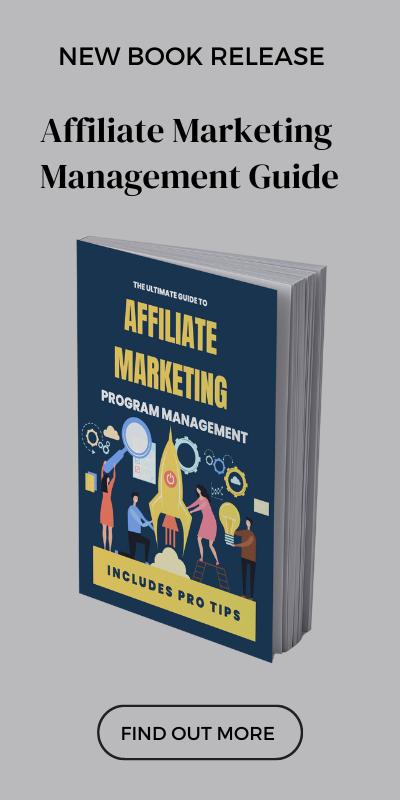Your Partners, Your Choice
Any brand working through an affiliate network has the choice to approve or reject every website that applies to their program. It is always my recommendation to do this, as you are in control of who speaks about your brand, and how they are promoting you. Don’t want to work with discount partners? Not a problem, just callout in your program terms and reject any that still apply. I’ve worked with brands in the past that use affiliates as purely content, and as such, only carefully approve only websites that fit their specific criteria.
Performance Led Sales
With other marketing channels, a large percentage of costs are delivered upfront. You pay per click for example with PPC in the hope that that customer will convert on site. In the affiliate channel, you are only paying out once a customer purchases. This model puts the onus on the partner to deliver the best quality traffic to encourage more orders. In some cases, this means they might carry the upfront costs, whether it be bidding on your behalf in Google Shopping or creating great content. So, I would encourage offering good commission rates to offset these costs.
Different Payment Models
Nearly all affiliate networks offer brands multiple different ways to pay their partners. The most popular is Cost per Sale, whereby whoever was the last touchpoint for the customer before purchase receives the full commission. Other brands like car dealerships might prefer a Cost per Lead or Cost per Call model. It is important to find the right payout scheme for your business model.
Recently, a greater focus on attribution and the need to pay more partners fairly has seen new models gain prominence. It is now possible with some networks to split the commission between all partners involved in a purchase. Or, pay a bonus to any partner that assisted a sale but wasn’t the last click.
If possible, I would recommend offering multiple ways for affiliates to earn a commission. It encourages them to create more content and advertise your brand as the odds are higher for earning. This is key to continued growth within the channel.
Low Entry
Embarking on launching a new marketing channel can often be expensive. There can typically be upfront media costs, monthly retainers, along with potential new staff employed to grow it—all of this without the guarantee of anyone purchasing from you.
In the affiliate channel, the barriers to entry are relatively low. As mentioned, you are only paying out any commissions to partners if they deliver a qualified customer. Monthly retainers with networks are generally small, as many have built entry models for startups and SME’s to launch programs with less fear. To combat this, their ‘fee’ or monthly override (a % of all commissions paid to partners) is around 20-30%. Again, you are only paying this if partners start driving orders.
Diversify Revenue Streams
As online businesses, we are primarily at the mercy of big corporations like Google, Facebook, and Amazon. Right now, you could be dominating your search terms, but we all know a Google update can easily eradicate years of hard work. The same with social algorithms lowering engagement rates overnight.
Diversification is vital and never rely on one channel or revenue stream to prop up your business. Affiliates can offer you an additional revenue stream that can be nurtured and grown. We would typically see the affiliate channel deliver a sales mix of around 10-30% for nearly all programs.
Brand Awareness and Growth
By working with a wide variety of partners, you gain the chance to test your current brand awareness and put in place strategies for growth. Cashback and discount partners are primarily at the bottom of the sale funnel. So, if you start seeing orders and traffic coming through them, then that can provide a barometer of your current brand awareness.
Top partners on our programs have audiences upwards of 5m. If you are looking to grow and acquire new customers, then these are core affiliates for increasing brand awareness.
Test New Markets
When working with an affiliate network, you gain access to a web of potential new markets. Large networks have a presence in most major territories which can make launching there seamless. Utilising the same tracking technology, you can almost instantly start reaching out and onboarding partners. By speaking to them and building relationships, companies can gain insight into brand perception. Using this knowledge insight alongside the data the networks provide you have a case study for potentially opening the market up to more investment.
Grow Existing Partnerships
It is almost impossible to find online brands that don’t already have partnerships across different mediums. Are there bloggers you have gifted products to or a social media influencer that has called out your brand? These relationships can be built upon.
Affiliate networks do a lot of the heavy lifting with regards to educating people about affiliate marketing. They also have specialist teams recruiting new partners onto the network. Utilise their knowledge bases to help your partners join your program. You can then explain to your partners how they can earn revenue by continuing to talk about the brand. Some brands might want to bring affiliates into the conversation as a way of negotiating a hybrid package of tenancy + commissions in return for content moving forward.
SEO Benefit
There is still a lot of contentious opinion as to how active affiliate links are towards SEO, and if they boost rankings at all. But, there is no denying that Google and other search engines like it when you have links from high ranking domains. Within the affiliate space, you will find high ranking domains like The Telegraph, Buzzfeed and Business Insider, to name a few.
Targeted Traffic
By working with selective affiliate partners, you can start creating a stable of sites from where your potential customers are more likely to visit. This increases the chances of sending targeted traffic through to your website. With mostly open platforms like social channels or search engines, anybody could stumble across your site and click through. It can work sometimes, but more often than not, it will increase your bounce rate and lower conversion rates as they realise they have no interest.
If you are a fashion e-commerce site and you partner with a fashion aggregator platform like Lyst or Shopstyle. Then there is a higher propensity to deliver a qualified customer.
Conclusion
Here we have listed multiple reasons as to why you should launch an affiliate program. But in particular, the barriers of entry are low, and the ROI from partnerships are usually £10 plus. I would suggest having a look at competitors – do they have a program live, what are their commission rates and what partners do they work with?
If you want to supercharge your program, then often you will not get the account management you need from networks. Their time is focused towards the large accounts. Here is where an OPM (Outsourced Program Manager) might be required. Working as an extension of your team, they can do all the nitty-gritty work for you and help build strategies and incentives to make the affiliate channel more successful for you.




